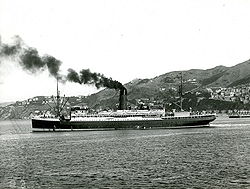Willochra
|
||||||||||||||||||||
|
||||||||||||||||||||
|
||||||||||||||||||||
|
||||||||||||||||||||
|
||||||||||||||||||||
The Willochra was a passenger ship put into service in 1913 by the Australian shipping company Adelaide Steamship Company , which was in service under the name RMS Fort Victoria after being sold to the Furness, Withy & Co. Empire in 1919 . The ship sank in 1929 after a ship collision shortly after leaving New York Harbor .
The ship
The 7,784 GRT steamship Willochra was built at the William Beardmore and Company shipyard in Dalmuir , Scotland . The 125.36 meter long and 17.28 meter wide ship was built for the Adelaide Steamship Company, which was based in Adelaide . She was equipped with two quadruple expansion steam engines that made 1374 nominal horsepower and with which a top speed of 16 knots (29.6 km / h) enabled.
The Willochra had two sister ships that were built at the same shipyard: the Warilda (7,713 GRT), which was sunk in the English Channel by a German submarine on August 3, 1918 , and the Wandilla (7,785 GRT), which arrived on September 10, 1942 Libya was sunk in a British air strike . The three steel- built ships each had a chimney, two masts, two propellers and were equipped with passenger accommodation for 231 passengers in the first, 120 in the second and 72 in the third class.
The Willochra was launched on August 14, 1912 and was completed on February 7, 1913. In the same year she was temporarily chartered by the New Zealand shipping company Union Steam Ship Company (USS Co.). From 1914 the ship served as a troop transport for the Royal Australian Navy in the First World War .
In 1919 the ship was sold to the Quebec Steamship Company, which was part of the British shipping company Furness, Withy & Co. based in Montreal . The steamer was named RMS Fort Victoria before it went to the Bermudas & West Indies Steamship Company in 1921, which also belonged to Furness, Withy & Co. and was based in Hamilton , Bermuda . The ship was equipped with accommodation for 400 first class passengers and used in the New York-Bermuda service.
On December 18, 1929, the Fort Victoria cast off with 255 passengers on board under the command of Captain Albert R. Francis for another voyage from New York to Hamilton. As the fog was thick, the ship stopped in the Ambrose Channel to wait for the weather to improve. She was rammed by the Algonquin , a passenger steamer of the American shipping company Clyde-Mallory Line. The Algonquin wanted to arrive in New York from Galveston . Her bow bored into the port side of Fort Victoria .
Both ships then made distress calls that were received by the United States Coast Guard and other ships in the vicinity. All passengers and crew were rescued before Fort Victoria sank. Their wreck lies at the position of 40 ° 28 '36 " N , 73 ° 53' 6" W . The Vickers-Armstrong shipyard was commissioned to build a replacement, the Monarch of Bermuda , which entered service in 1933.
